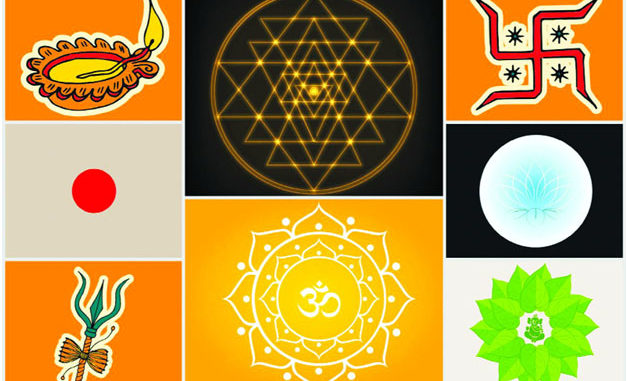
Hinduism is full of symbolism—arguably no other religion employs the art of symbolism as effectively as the Hindus. Most of these symbols are representative of the philosophies, teachings, omen, and even the gods and goddesses.
In Hinduism, symbols play a major ritual in social life, culture, and rituals. Hinduism is full of powerful theories and philosophies which find similarity with the modern science. Over time many concepts of Hinduism are gaining credibility among modern scientists.
Let us look at major symbols of Hinduism and their deep meaning they convey.
Aum
The Aum (Om)) is the most important spiritual Hindu symbol and its sound is used in meditation. In Hinduism, the word “Om” is the first syllable in any prayer.
More specifically, Om is used to signifying the universe and the ultimate reality. Some people say that this symbol represents the three aspects of God: the Brahma (A), the Vishny (U), and the Shiva (M).
Om is a foundation of Hinduism, where it is considered the very first sound of the universe. “Before the sound Om, there was nothing.” It is sometimes wrongly pronounced as ‘Om.’ The correct pronunciation however is ‘Aum’. The ‘A’ here represents creation, ‘U’ is manifestation, and ‘M’ is destruction.
Lotus
The lotus is a very important symbol of Indian cultural heritage. Hindu scriptures are full of praises of the lotus because it is very sacred to all the Gods.
God Brahma and Buddha are both shown sitting on a lotus. The Sun is also like a red lotus rising from the blue ocean/sky. Lord Vishnu holds a lotus in one of His left hands. Goddess Lakshmi also holds a lotus, presumably because both were obtained from the ocean churning.
It is a water-borne flower, yet not even a drop of water stays on the lotus or its leaf, so it is regarded as the most appropriate symbol of detachment from surroundings.
Tilak, Dot, Bindu
Our ancient human ancestors saw the shape and form of their own body on earth and he also saw the burning ball-like shape of the Sun in the sky.
This was his first acquaintance with shape. Then, they also saw the clouds assuming random shapes and dimensions so they start to give shapes and forms to their own ideas and thoughts and realized that the starting point of all shapes and forms is a point. Geometry recognizes the point as a shape without dimensions which, though it cannot be described, still exists. Every drawn line is a string of points so he conceived a starting point to describe his thoughts, visions, and emotions and to express them with the help of his own sound.
Thus, sound and point became intertwined. A dot or point is the seed of language expressed by sound so it was the finale of the highest attainment.
A dot or point is the abode of Shiva-Shakti, Vishnu- Lakshmi-Shakti. Every person belonging to any society or civilization had an indomitable will and urge to communicate his thoughts, emotions, and experiences to indicate their distinct identity, so symbols were developed.
Swastik
For success in every undertaking human beings pray to God by invoking hymns, singing praise, recitations, etc. The Rishis had determined a shape as a symbol to propitiate cherished desire. The root of Swastik is su + us su means benefic and us means existence; whosoever desires to have glory, prosperity, progress, success, etc. is advised to invoke the Swastik Yantra.
The swastika is also one the most recognized Hindu Symbol outside India. This however has to do with its infamous association with Nazi Germany symbol.
Shree Chakra or Shree Yantra
Sri Yantra – symbol of formed by nine interlocking triangles that radiate out from the central point.
The Garbh-Grah — sanctum sanctorum, of Lord Venkateshwara’s temple in India, has a highly powerful Shreeyantra beneath the foundation, so this temple has become a wish-fulfilling holy place for real devotees. It is the richest temple in India.
It is claimed that a Shree Yantra made with five precious metal alloys in the prescribed composition as laid down by the Rishis and sanctified by a Siddha saint, acquires undisputable potency of bestowing riches on the devotee for several years as per the potency infused in it.
Sir John Woodruff and Dr. N.J. Button of U.K., and Dr. Zejerta of Germany have undertaken a deep study and research on the scientific construction and celestial effects of Shree Yantra. In Russia, Dr. Alexi Kulaicheva has attempted to analyse and study the formation of Shree Chakra or Shree Yantra on a computer to establish its precision and accuracy.
Rudraksha
Rudraksha is the seed (stone) of a fruit of a rare species of a tree found in Nepal, Java, Sumatra and Malaya. In India, it has been found in Haridwar and spotted at some centers in Konkan and Karnataka. It is roundish with a cellular demarcation and has a central bore. Small or unripe, unmatured seeds are of no value.
Rarely, a seed with no bore is also seen but then it becomes a piece of great sanctity value if it has only 1 cell mark. The cellular mark/division varies from 1 to 21 per seed. The Rishis observed these peculiarities and made detailed investigations because they noticed that every seed is a ball of energy but the efficacy quantum differed from piece to piece with different cellular markings but there was no difference in any two identical seeds.
Rudraksha holds a place of pride in the Rigveda, Atharvaveda, Skand Puran, and other scriptures because of their beneficial properties of attracting healthy vibrations. Saints wear it as a necklace; the Rishis had deified it as an ornament of Lord Shiva.
Sacred Thread
To encourage cooperation and establish order in society, Hindus had divided the life span of every person into four distinct divisions — Brahmacharya — the celebate life of a student; Grihasta — family life; Vanprastha — the third portion of life when a person should detach himself from family bonds and endeavour to serve the society; and Sanyasa — when a person should finally renounce the world. In this final stage, the person ceases to belong to his family, caste, or creed. Instead, he devotes himself to spread the message of the scriptures of love and benevolence and simultaneously practices Yogic Sadhna to illuminate his own self to attain salvation.
There is no sanction for leading an idle life and becoming a burden on society or to look to pass life in an old-age-home run with the help of others. To make life simpler and enjoyable, Lord Shree Krishna preached secularism, saying, “I have divided mankind in four stages (Ashrams) as per their competence/capability and deeds (calling) or professions so, there is no need for any class conflict, or haves and have-nots in society.”





Be the first to comment